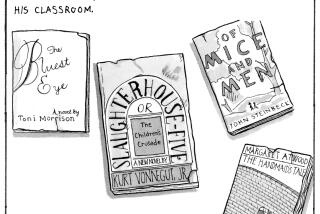An interview with Stephan Pastis: Writing funny books for kids
Stephan Pastis, the former lawyer-turned-cartoonist behind the daily comic strip “Pearls before Swine,” (which runs in 650 newspapers, including the Los Angeles Times) recently made his first foray into long-form chapter books with “Timmy Failure: Mistakes Were Made”). While it should come as no surprise to anyone familiar with Pastis’ irreverent sense of humor that the heavily illustrated whodunit is crammed with sly inside jokes, clueless characters and a hulking polar bear sidekick motivated by chicken nuggets and Rice Krispies Treats. What may come as a surprise is that his first book, which focuses on the misadventures of an 11-year-old detective, is geared toward the younger reader.
In advance of Pastis’ upcoming appearance at the Los Angeles Times Festival of Books we caught up with him by phone at his Northern California home to ask about his recent adventures beyond the three-panel strip.
Stephan Pastis is scheduled to participate in the 11:00 a.m. panel discussion “Middle Grade Fiction: Tweens On The Loose,” on the YA Stage of the Los Angeles Times Festival of Books at USC on Saturday, and signing copies of “Timmy Failure: Mistakes Were Made” afterward.
The book jacket for “Timmy Failure: Mistakes Were Made” notes that it’s for ages 8 to 12, but I found plenty of things to amuse my adult brain as well, one example being a chapter titled: “You May Find Yourself Behind the Wheel of a Large Automobile,” which I recognized as a line from a Talking Heads song. Were you intentionally trying to reach two audiences?
The titles are there for the adults – there’s [also references to] a lot of Bob Dylan songs, and in the second book there’s an Ingmar Bergman film [reference]. I obviously know the kids won’t get it. But in terms of the text of the book -- it’s funny because I know where the book is categorized and I know who it’s for so I obviously didn’t include beer and cigarettes and swearing – but other than that I didn’t make any concessions, I just wrote what I write, which is the same thing I do with the strip. And it turns out that when I do that, the people it appeals to are mostly people that are 12. But I don’t write down to kids.
So that’s why the book is sprinkled with words like “mendacity” and “recidivism”?
Mendacity is a funny word. I think it’s Burl Ives in “Cat On a Hot Tin Roof,” who walks around the room and says “mendacity” over and over and I loved the way he said it. So that’s where that comes from.
You mentioned a second book and I did happen to notice that there’s a “No. 1” printed in the upper right hand corner of the book cover. Is it safe to assume that we haven’t seen the last of Timmy Failure and his Total Failure Inc. detective agency?
Wouldn’t it be funny if there weren’t going to be any other books and there was just going to be that “No. 1” there? That’d sort of be like the guy who introduces his one and only wife as his “first wife.” But yes, I wrote the second one over the most recent summer and this summer I’ll write the third one. … I do the books just during the summer so it’s their own little block of time.
I know you have children; did you seek their input as you were working on the book?
A: Yes, I have a boy, Thomas, who is 15 and a girl, Julia, who is 11. And I didn’t only [seek their input] I was there with them in the room – about six inches away from them – as they read it. I wanted to see not only what they thought of the overall book, I wanted to know if the laughs were in the right place, and if they got certain things. And I was totally annoying, when they laughed I’d pop in and say OK, where did you laugh? And they’d say here and say OK, why did you laugh? And they’d tell me. They learned after a while to stop laughing so they could read the book in peace. Thomas, my 15-year-old, is effectively my editor, I’ve always trusted his voice more than anybody, on the strip for years, he has one of those ears that’s just tuned to the rhythm of humor, so if he says something’s not funny, my stomach just hurts because I know he’s right and it’s already been drawn.
I feel like a lot of the humor of this book comes from that kind of rhythm of humor like describing Timmy’s study partner, Rollo Tookus, as “dull as sand” followed by a drawing of a chubby kid standing next to a pile of sand.
For most of the books in this genre that I’ve seen, the illustration is not always essential; you can cover up the illustrations and the narrative would be fine. I wanted this to be more like – and this is an odd inspiration for a kid’s book – Kurt Vonnegut’s novel “Breakfast of Champions.” That [book] had a big influence on me, and in that book you couldn’t cover up the drawings and still get it -- you needed to see the drawings as part of the narrative.
Your comic strip “Pearls Before Swine” is home to all manner of critters – pig, rat, zebra, goat, and crocodile – why give Timmy a polar bear business partner?
This was something I realized afterward -- because I didn’t think of it at the time – but I think the reason is that Timmy doesn’t have a dad, so the polar bear’s size subliminally indicates protection. Timmy is somehow protected, but at the same time the polar bear is soft and he has all this thick fur so he’s comforting. To me, if I look back on it, it would appear to be because it creates comforting dad-type figure.
One of the things Timmy does in the book is immortalize the founding principle of his detective agency in ink on the sole of his left shoe. What would you immortalize in ink on the bottom of your left shoe?
“Don’t be a lawyer” -- how about that?
ALSO:
Cathy Guisewite slowly turns past the comics page
Introducing the Los Angeles Times Literary Map of L.A.
George Orwell’s Indian birthplace dedicated to Gandhi; locals fume
More to Read
Sign up for our Book Club newsletter
Get the latest news, events and more from the Los Angeles Times Book Club, and help us get L.A. reading and talking.
You may occasionally receive promotional content from the Los Angeles Times.







